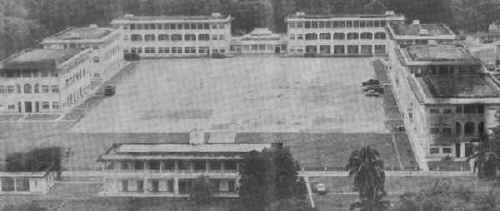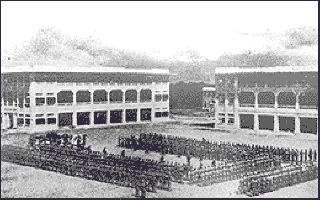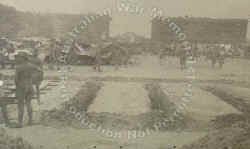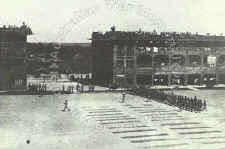 |
The SELARANG INCIDENT,
CHANGI, 1942 |
The
clearest indication of the Japanese contempt for their prisoners came in
September 1942. During the previous month General Percival and most of
the other senior British and Australian officers had been taken away to
Japan, and Colonel Holmes and Colonel Galleghan were left in command of
the 20,000 or so prisoners who now remained at
Changi.
At the same time
Major General Fukuye and a large administrative staff arrived to
establish a proper prisoner-of-war camp regime. Hardly had Fukuye
arrived when four escaped prisoners were brought in.
Two of these had got away from Bukit
Timah in May, and had rowed 200 miles In a small boat before re-arrest.
The Japanese, who refused to recognize the right of any prisoner-of-war
to attempt to escape, announced on 30th August that all prisoners were
to be given the opportunity to sign the following statement: 'I the
undersigned, hereby solemnly Swear on my honour that I will not, under
any circumstances, attempt to escape.' Colonel Holmes pointed out that
prisoners-of-war were not allowed to give their parole, and he and his
fellow officers refused to sign.
Click
for audio
 |
This
photo shows the 2nd Battalion Gordon Highlanders on parade (in
the famous hollow square formation), on the Selarang Barracks
Square circa 1940 |
To a man the other ranks followed
suit. Two days passed, with no sign of the next Japanese move. Then, on
the morning of 2nd September, the senior commanders were ordered to
witness the execution of the men who had tried to escape. The victims
were dragged to Selarang Beach and ordered to dig their own graves.
Corporal Breavington, one of the two Australians from Bukit Timah,
pleaded that his comrade should be spared, saying he had ordered him to
escape with him. His plea was in vain, and just before they were riddled
with bullets both men stood to attention and saluted their Colonel. 'The
bravest man he had ever seen', was Colonel Galleghan's tribute to his
corporal.
Hard on the heels of this cold-blooded
massacre came the Japanese order that all the British and Australian
prisoners, apart from those in Roberts Hospital, were to concentrate at
Selarang. This whole move, ordered at midday, had to be finished in five
hours, and that night 15,400 men were crammed into Selarang Barrack
Square, with only two water taps and totally inadequate latrines.
For
three days the prisoners held out . . .
and
photographs
preserving the incredible scene for posterity were taken at risk of the
photographer's life.
 |
<
Selarang Barracks Square in wide shot, 1942 |
Close up of Selarang
Barracks Square, 1942 > |
 |
The allied commanders knew that their
men could not live in such conditions for long (the Japanese had even
threatened to bring to the square the diphtheria cases from the hospital) and they pleaded for the declaration to be either amended or
made an order. Eventually the Japanese made it an order, whereupon the
British and Australian commanders ordered their men to sign the
declaration under duress, pointing out that they would otherwise die of
disease.
 |
 |
|
Selarang Barracks,
Singapore. 1942-09.
Photograph taken during the Selarang barracks square incident when
Japanese general Fukuye concentrated 13350 British and 2050
Australian prisoners of war because of their refusal to sign a
promise not to escape. The picture shows external excavations for
latrines made necessary because of overcrowding in the barracks.
(donor s. Elliman) |
This photo of the
parade ground January 1943 clearly shows where the trench latrines
had been.
Changi,
Singapore, 1943-01-26. The 2/29th Battalion, AIF, advancing in
review order during an Australia Day parade held on Selarang
barracks square.
|
Reluctantly, yet sensing an element of
victory in the stand they had made, the men signed and on 5th September
they were allowed to return to their former areas, any illusions they
might previously have entertained about the Japanese having now been
completely shattered.
An extract from Changi
History |